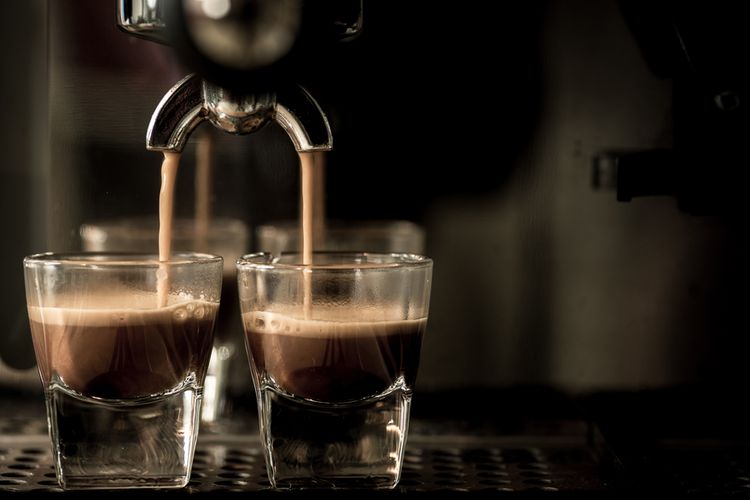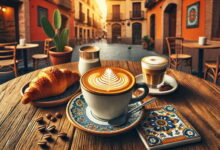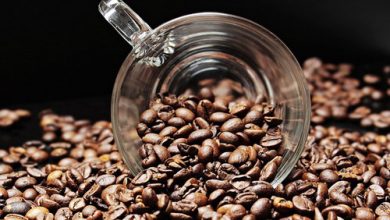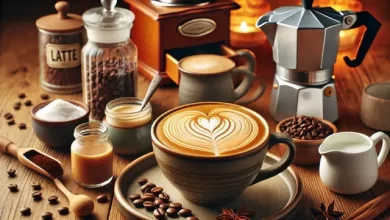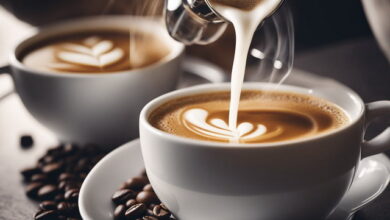Discover the Surprising Caffeine Content in a Double Shot Espresso
Caffeine Content in a Double Shot Espresso
Espresso, with its rich flavor and quick preparation time, has become a staple in coffee culture worldwide. Among its variations, the double shot espresso stands out for those seeking a stronger, more robust coffee experience. This concentrated form of coffee not only delivers a powerful taste but also packs a significant amount of caffeine, making it a popular choice for individuals looking for an energy boost. Understanding the caffeine content in a double shot espresso is crucial for both coffee enthusiasts and those mindful of their caffeine intake.
Caffeine, a natural stimulant found in coffee beans, is the primary reason many turn to coffee for an alertness boost. A double shot espresso, typically containing around two ounces of concentrated coffee, has a caffeine content that can vary based on several factors. These factors include the type of coffee bean used, the roast level, and the brewing method. On average, a double shot of espresso contains approximately 60-100 milligrams of caffeine, though this can vary slightly. This range is significantly higher per ounce compared to regular brewed coffee, making espresso a potent source of caffeine.
Despite its small volume, a double shot espresso delivers a substantial amount of caffeine quickly, which can have both positive and negative effects on health. For many, the immediate increase in alertness and energy levels is a major benefit. However, it’s important to be aware of the potential downsides, such as increased heart rate, anxiety, or disrupted sleep patterns, especially for those sensitive to caffeine. By understanding the caffeine content and its effects, consumers can make informed choices about their espresso consumption, balancing enjoyment with health considerations.
The Amount of Caffeine in a Double Shot Espresso
Caffeine is the world’s most widely consumed psychoactive substance, and espresso, particularly the double shot variety, is a popular way to get a quick caffeine fix. A double shot espresso, also known as a doppio, is simply two servings of espresso in one cup, providing a concentrated burst of caffeine and flavor. But exactly how much caffeine does a double shot espresso contain, and how does it compare to other caffeinated beverages?
Understanding Espresso and Its Caffeine Content
Espresso is made by forcing hot water through finely-ground coffee beans under high pressure. This method extracts a highly concentrated form of coffee, rich in flavor and caffeine. A single shot of espresso, which is typically about 1 ounce (30 milliliters), contains approximately 63 milligrams of caffeine. Therefore, a double shot espresso, being twice the quantity, contains around 126 milligrams of caffeine.
Factors Influencing Caffeine Content
Several factors can influence the exact amount of caffeine in a double shot espresso. These include:
- Type of Coffee Beans: Arabica beans generally contain less caffeine than Robusta beans. The blend used in making the espresso can thus affect the caffeine content.
- Roast Level: Darker roasts have slightly less caffeine than lighter roasts because the roasting process reduces the caffeine content to a small extent.
- Grind Size and Brewing Time: Finer grinds and longer brewing times can increase the caffeine extraction, leading to a higher caffeine content in the espresso.
Comparing Caffeine Content
To put the caffeine content of a double shot espresso into perspective, it’s useful to compare it with other common caffeinated beverages. A typical 8-ounce cup of brewed coffee contains about 95 milligrams of caffeine, which means a double shot espresso has more caffeine per ounce but slightly less overall than a standard cup of coffee. On the other hand, an 8-ounce energy drink contains about 80 milligrams of caffeine, making the double shot espresso significantly more potent.
Health Implications
Moderate caffeine consumption is generally considered safe for most people and can even have some health benefits, such as improved alertness and concentration. The FDA suggests a daily caffeine intake of up to 400 milligrams for adults, which would be equivalent to about three double shot espressos. However, sensitivity to caffeine varies widely among individuals. Some people may experience adverse effects such as jitteriness, anxiety, or insomnia even at lower doses.
Double Shot Espresso: Understanding Its Caffeine Content
When it comes to coffee, the espresso holds a special place in the hearts of caffeine enthusiasts. The double shot espresso, in particular, is a favorite for its bold flavor and potent caffeine kick. But just how much caffeine does a double shot of espresso contain? Let’s delve into the details.
What is a Double Shot Espresso?
A double shot espresso, often referred to as a “doppio,” is made using twice the amount of coffee grounds as a single shot. Typically, a single shot of espresso is extracted from about 7-9 grams of finely ground coffee beans, yielding approximately 1 ounce (30 ml) of coffee. A double shot uses 14-18 grams of coffee grounds, producing around 2 ounces (60 ml) of rich, concentrated espresso.
Caffeine Content in Espresso
The caffeine content in coffee can vary widely depending on several factors, including the type of coffee bean, the roast level, and the brewing method. Espresso, being a concentrated form of coffee, has a higher caffeine content per ounce compared to regular drip coffee.
On average, a single shot of espresso contains about 63 milligrams of caffeine. Therefore, a double shot would contain approximately 126 milligrams of caffeine. However, this can vary slightly based on the factors mentioned earlier.
Factors Influencing Caffeine Content
Several factors can influence the caffeine content in a double shot of espresso:
- Type of Coffee Bean: Arabica and Robusta are the two primary species of coffee beans used in espresso. Arabica beans generally contain less caffeine than Robusta beans. Blends that include a higher percentage of Robusta will result in a more caffeinated espresso.
- Roast Level: The roasting process can affect the caffeine content. Contrary to popular belief, darker roasts do not contain more caffeine than lighter roasts. In fact, lighter roasts often have slightly more caffeine because the beans are denser.
- Grind Size and Extraction Time: The fineness of the grind and the extraction time can also impact the caffeine content. A finer grind and a longer extraction time can lead to a higher caffeine concentration.
- Brewing Method: The espresso machine and the brewing technique can influence the caffeine content. Baristas with different techniques might extract slightly different caffeine levels.
Comparing to Other Coffee Drinks
To put the caffeine content of a double shot espresso into perspective, it’s helpful to compare it to other popular coffee drinks:
- Drip Coffee: A standard 8-ounce cup of drip coffee typically contains between 95-165 milligrams of caffeine. This means that a double shot of espresso has a comparable caffeine content to a small cup of drip coffee, but it’s consumed in a much smaller volume.
- Americano: An Americano is made by diluting a shot (or double shot) of espresso with hot water. The caffeine content of an Americano will be the same as the espresso shot(s) used, but the drink will have a milder flavor due to the added water.
- Latte or Cappuccino: These popular espresso-based drinks contain a double shot of espresso as their base, so their caffeine content will be similar to that of a double shot. However, the addition of steamed milk makes these drinks less concentrated and more voluminous.
Health Considerations
Moderate caffeine consumption is generally considered safe for most people. The FDA recommends a daily caffeine intake limit of up to 400 milligrams, which is roughly equivalent to four 8-ounce cups of brewed coffee or about three double shots of espresso. However, individual tolerance to caffeine can vary, and some people may experience jitters, insomnia, or increased heart rate with higher caffeine consumption.
How Much Caffeine is in a Double Shot Espresso?
Espresso, the cornerstone of many coffee beverages, is celebrated for its robust flavor and rich aroma. When you order a double shot of espresso, you’re not just getting an intense coffee experience; you’re also ingesting a significant amount of caffeine. But how much caffeine is actually in that small, potent drink?
Understanding Espresso and Its Caffeine Content
Espresso is made by forcing hot water through finely-ground coffee beans at high pressure. This process extracts flavors and compounds quickly, resulting in a concentrated coffee shot. A standard single shot of espresso is typically about 1 ounce (30 milliliters) and contains roughly 63 milligrams of caffeine. A double shot, therefore, doubles these amounts, giving you about 2 ounces (60 milliliters) of espresso with approximately 126 milligrams of caffeine.
Factors Influencing Caffeine Content
While these figures are widely accepted, the exact caffeine content in a double shot of espresso can vary based on several factors:
- Type of Coffee Bean: Different coffee beans have different caffeine levels. Robusta beans, for instance, contain nearly twice as much caffeine as Arabica beans. If your espresso is made with Robusta beans, it will have more caffeine.
- Roast Level: The roast level of the coffee beans also plays a role. Contrary to popular belief, darker roasts generally have slightly less caffeine than lighter roasts because some caffeine is lost during the roasting process. However, the difference is minimal and might not significantly impact the caffeine content in your espresso.
- Grind Size and Brewing Time: The grind size of the coffee beans and the brewing time can affect the caffeine extraction. Finer grinds and longer brewing times typically result in higher caffeine content. Espresso is brewed quickly, but variations in grind size and extraction time can lead to slight differences in caffeine levels.
- Barista Technique: The skill and method of the barista can also influence the caffeine content. The amount of coffee used, the pressure applied, and the consistency of the grind all contribute to the final caffeine concentration.
Comparing to Other Coffee Drinks
To put the caffeine content of a double shot espresso into perspective, let’s compare it to other common coffee drinks:
- Drip Coffee: A standard 8-ounce (240 milliliters) cup of drip coffee contains approximately 95 milligrams of caffeine, though this can vary widely. This means that a double shot of espresso has more caffeine per ounce than drip coffee, but less overall caffeine due to the smaller serving size.
- Latte or Cappuccino: These popular espresso-based drinks typically contain one or two shots of espresso. A double shot latte or cappuccino, therefore, has the same amount of caffeine as a double shot of espresso, around 126 milligrams. However, the milk in these beverages can dilute the strong coffee flavor.
- Instant Coffee: An 8-ounce cup of instant coffee generally contains about 63 milligrams of caffeine, which is roughly equivalent to a single shot of espresso. Therefore, a double shot espresso has about twice the caffeine of an instant coffee serving.
The Impact of Caffeine
Caffeine is a natural stimulant that can improve focus and energy levels. For many, a double shot of espresso provides a quick and effective caffeine boost. However, it’s important to consume caffeine in moderation. Excessive caffeine intake can lead to side effects such as jitteriness, increased heart rate, and insomnia.
The general recommendation for healthy adults is to limit caffeine intake to 400 milligrams per day. This means that a double shot of espresso, with its 126 milligrams of caffeine, can be part of a balanced caffeine consumption plan.
Double Shot Espresso vs. Regular Coffee: A Caffeine Showdown
Coffee lovers often find themselves debating the merits of different coffee preparations, especially when it comes to caffeine content. Two popular choices are double shot espresso and regular coffee. Understanding the differences between these two can help coffee enthusiasts make informed decisions about their caffeine consumption and overall coffee experience.
What is Double Shot Espresso?
Espresso is a concentrated form of coffee made by forcing hot water through finely-ground coffee beans under high pressure. A double shot espresso, also known as a doppio, consists of two shots of espresso extracted in the same amount of time it takes to make one. This results in a stronger, more concentrated flavor and higher caffeine content than a single shot.
What is Regular Coffee?
Regular coffee, often referred to as drip coffee or filter coffee, is made by brewing ground coffee beans with hot water. The water is poured over the grounds and filtered through a paper or metal filter, resulting in a less concentrated beverage compared to espresso. Regular coffee is typically served in larger quantities, such as an 8-ounce cup.
Caffeine Content: A Closer Look
The primary difference between double shot espresso and regular coffee lies in their caffeine content.
- Double Shot Espresso: A standard double shot espresso contains approximately 120 milligrams of caffeine. This amount can vary slightly depending on the type of beans used and the brewing method, but it generally falls within this range.
- Regular Coffee: An 8-ounce cup of regular coffee typically contains around 95 milligrams of caffeine. However, this can vary widely based on factors such as the coffee bean type, grind size, and brewing time. Some strong brews can contain up to 200 milligrams of caffeine in an 8-ounce serving.
While it might seem that a double shot espresso is the clear winner in terms of caffeine content, it’s important to consider the serving size. Regular coffee is often consumed in larger volumes, which means the total caffeine intake can easily surpass that of a double shot espresso.
Flavor and Experience
Beyond caffeine content, the flavor profile and overall experience of drinking these two types of coffee differ significantly.
- Double Shot Espresso: Known for its intense and robust flavor, espresso has a thicker consistency and a rich, creamy texture. The concentrated nature of espresso means that it delivers a quick, powerful burst of flavor, often enjoyed in smaller quantities. Espresso is the base for many popular coffee drinks, such as lattes, cappuccinos, and macchiatos.
- Regular Coffee: Regular coffee has a milder, more diluted flavor compared to espresso. The larger serving size allows for a more leisurely drinking experience, often enjoyed over an extended period. Regular coffee’s flavor can vary greatly depending on the beans used and the brewing method, offering a wide range of taste experiences.
Health Considerations
Both double shot espresso and regular coffee offer various health benefits, primarily due to their caffeine content and antioxidant properties. Caffeine can enhance mental alertness, improve physical performance, and even support weight loss. Additionally, coffee contains antioxidants that help combat inflammation and reduce the risk of certain diseases.
However, it’s crucial to consume caffeine in moderation. Excessive caffeine intake can lead to side effects such as jitteriness, insomnia, and increased heart rate. The recommended daily caffeine intake for most adults is up to 400 milligrams, which equates to about four 8-ounce cups of regular coffee or three double shot espressos.
Caffeine Comparison Between Double Shot Espresso and Drip Coffee
Caffeine, the stimulant found in coffee, is a crucial component for many who rely on it to kickstart their day. While the types of coffee are diverse, two popular options often come up for comparison: the double shot espresso and drip coffee. Both beverages have their unique characteristics and caffeine content, which makes understanding their differences essential for coffee enthusiasts and those mindful of their caffeine intake.
Understanding Double Shot Espresso
Espresso is a concentrated form of coffee, typically served in small, strong shots. A double shot, or doppio, contains approximately 60 milliliters of espresso, created by forcing hot water through finely-ground coffee beans using high pressure. The process results in a thick, rich coffee with a robust flavor and a creamy layer called crema on top.
In terms of caffeine content, a double shot espresso typically contains about 120 milligrams of caffeine. This amount can vary slightly depending on the type of coffee beans used, the grind size, and the brewing time. The high-pressure extraction process contributes to a higher concentration of caffeine in a smaller volume of liquid compared to other brewing methods.
Understanding Drip Coffee
Drip coffee, on the other hand, is prepared by allowing hot water to drip through a filter containing ground coffee. The water extracts flavors and caffeine from the grounds as it passes through, eventually collecting in a pot or carafe. Drip coffee makers can vary in size and brewing time, but they generally produce a larger volume of coffee compared to espresso machines.
A typical 8-ounce cup of drip coffee contains about 95 milligrams of caffeine. However, this can also vary based on the type of coffee beans, the coarseness of the grind, the amount of coffee used, and the brewing time. Drip coffee provides a more diluted flavor compared to espresso, making it a popular choice for those who prefer a milder taste.
Caffeine Content Comparison
When comparing the caffeine content of a double shot espresso to a cup of drip coffee, it’s essential to consider the serving size. A double shot of espresso (2 ounces) contains roughly 120 milligrams of caffeine, while an 8-ounce cup of drip coffee contains about 95 milligrams. This means that ounce for ounce, espresso is significantly more concentrated in terms of caffeine.
However, because drip coffee is typically consumed in larger quantities, the total caffeine intake can often be higher with drip coffee. For instance, a standard 12-ounce cup of drip coffee can contain approximately 140 to 190 milligrams of caffeine, depending on the factors mentioned earlier.
Factors Influencing Caffeine Levels
Several factors can influence the caffeine levels in both espresso and drip coffee. The type of coffee bean plays a significant role, with Robusta beans generally containing more caffeine than Arabica beans. The roast level also matters; lighter roasts tend to have slightly more caffeine than darker roasts because the roasting process reduces caffeine content.
Grind size and brewing time are crucial as well. Finer grinds and longer brewing times typically result in higher caffeine extraction. For espresso, the pressure and temperature used during extraction can affect the final caffeine content. For drip coffee, the ratio of coffee to water and the brewing temperature are important factors.
Choosing the Right Coffee
Ultimately, the choice between a double shot espresso and drip coffee comes down to personal preference and caffeine needs. If you prefer a quick, intense coffee experience with a higher concentration of caffeine in a smaller volume, espresso might be the way to go. On the other hand, if you enjoy sipping a larger cup of coffee over a longer period, drip coffee might be more suitable.
Both types of coffee offer unique flavors and experiences, and understanding their differences can help you make an informed choice based on your taste and caffeine requirements. Whether you’re an espresso aficionado or a drip coffee devotee, both options can provide the caffeine boost you need to start your day on the right foot.
Health Effects of Caffeine in a Double Shot Espresso
Caffeine, a natural stimulant found in various plants, has become a staple in many people’s daily routines. One of the most popular ways to consume caffeine is through espresso, particularly the double shot espresso, which packs a significant punch. Understanding the health effects of caffeine in this potent beverage is crucial for making informed choices about its consumption.
The Basics of Caffeine in Espresso
A double shot of espresso typically contains about 60-100 milligrams of caffeine, depending on factors like the type of coffee bean and the brewing method. This amount is roughly equivalent to a standard cup of brewed coffee, making it a concentrated source of caffeine. For many, this quick, intense dose of caffeine is what they seek to kickstart their day or provide a mid-day energy boost.
Positive Health Effects
- Improved Cognitive Function and Alertness
-
- Enhanced Mental Performance: One of the primary benefits of caffeine is its ability to improve cognitive function. Studies have shown that caffeine can enhance memory, mood, reaction times, and overall mental function. This is particularly beneficial in a work environment where concentration and quick thinking are essential.
- Increased Alertness: The stimulating effect of caffeine can help combat fatigue and improve focus. This is why many people turn to a double shot of espresso during periods of low energy.
- Physical Performance
-
- Boost in Physical Endurance: Caffeine is known to increase adrenaline levels in the blood, which prepares the body for physical exertion. This can lead to improved physical performance, making it a popular choice among athletes.
- Enhanced Fat Burning: Studies suggest that caffeine can increase the metabolic rate and promote fat burning, making it a helpful aid for those looking to lose weight or improve their fitness levels.
- Potential Health Benefits
-
- Reduced Risk of Certain Diseases: Regular caffeine consumption has been linked to a lower risk of several diseases, including Parkinson’s disease, Alzheimer’s disease, and some forms of cancer. The antioxidants in coffee also contribute to these protective effects.
- Improved Heart Health: Moderate caffeine intake has been associated with a reduced risk of heart disease. It is believed to improve heart function and reduce the likelihood of heart failure.
Negative Health Effects
- Increased Anxiety and Jitters
-
- Anxiety: High doses of caffeine can lead to increased anxiety, restlessness, and nervousness. Individuals sensitive to caffeine or those with anxiety disorders may find these symptoms particularly pronounced after consuming a double shot of espresso.
- Jitters: The stimulating effect can also cause jitters, which is an unpleasant sensation of trembling or shaking, particularly if consumed in large amounts or on an empty stomach.
- Sleep Disruption
-
- Insomnia: Caffeine can interfere with sleep patterns, leading to difficulty falling asleep or staying asleep. Consuming a double shot of espresso late in the day can significantly impact the quality of sleep, resulting in tiredness and reduced cognitive function the next day.
- Reduced Sleep Quality: Even if one manages to fall asleep, caffeine can reduce the quality of sleep, preventing the deep restorative sleep that is crucial for health and well-being.
- Digestive Issues
-
- Acid Reflux: Espresso, being acidic, can exacerbate symptoms of acid reflux or heartburn in sensitive individuals.
- Stomach Upset: The high concentration of caffeine can irritate the stomach lining, leading to discomfort or digestive issues.
- Dependence and Withdrawal
-
- Caffeine Dependence: Regular consumption of high doses of caffeine can lead to dependence. Missing a usual dose can result in withdrawal symptoms such as headaches, fatigue, and irritability.
- Tolerance Development: Over time, the body can build a tolerance to caffeine, requiring higher doses to achieve the same stimulating effects. This can lead to increased consumption and exacerbate any negative side effects.
FAQs About Caffeine in Double Shot Espresso
1. How much caffeine is in a double shot of espresso?
A double shot of espresso typically contains between 60 to 100 milligrams of caffeine. The exact amount can vary depending on factors such as the type of coffee bean, the roast level, and the brewing method.
2. How does the caffeine content in a double shot espresso compare to regular coffee?
On a per-ounce basis, espresso has more caffeine than regular brewed coffee. While a typical 8-ounce cup of brewed coffee contains about 80-100 milligrams of caffeine, a double shot of espresso (approximately 2 ounces) contains about 60-100 milligrams of caffeine.
3. What factors influence the caffeine content in a double shot espresso?
The caffeine content can be influenced by the type of coffee bean (Arabica vs. Robusta), the roast level (light, medium, or dark), and the brewing method. Additionally, the grind size and extraction time during brewing can also affect the caffeine content.
4. Is it safe to drink double shot espresso every day?
For most people, moderate consumption of double shot espressos is safe. However, it’s important to consider total daily caffeine intake from all sources. The FDA recommends a maximum of 400 milligrams of caffeine per day for most adults, which is roughly equivalent to four double shot espressos.
5. Can double shot espresso improve energy and focus?
Yes, the caffeine in double shot espresso can enhance alertness, focus, and energy levels. It works by stimulating the central nervous system, leading to increased mental and physical performance.
6. What are the potential side effects of drinking double shot espresso?
Common side effects of high caffeine intake can include increased heart rate, jitteriness, anxiety, digestive issues, and sleep disturbances. People with caffeine sensitivity or certain medical conditions should monitor their intake closely.
7. Does a double shot espresso have more caffeine than an energy drink?
It depends on the energy drink. Many energy drinks contain similar amounts of caffeine per serving, ranging from 80 to 200 milligrams. A double shot espresso usually falls on the lower end of this range but provides a more natural source of caffeine.
8. Can I decaffeinate my double shot espresso?
While you can’t remove caffeine from a regular double shot espresso, you can opt for decaffeinated espresso beans, which contain significantly less caffeine. A double shot made with decaffeinated beans typically contains about 2-5 milligrams of caffeine.
9. Is the caffeine content the same across all coffee shops?
No, the caffeine content in a double shot espresso can vary between coffee shops due to differences in coffee beans, roast levels, and brewing methods. It’s always good to ask or check the nutritional information provided by the coffee shop.
10. Can I customize the caffeine content in my double shot espresso?
To some extent, yes. You can ask for adjustments in the grind size or extraction time, or choose specific types of beans with lower or higher caffeine content. However, the changes might be subtle, and the overall caffeine content will still fall within a certain range.

